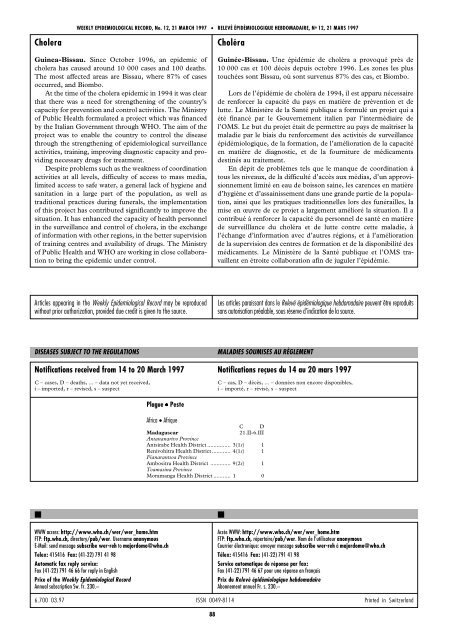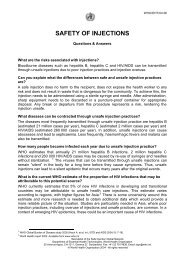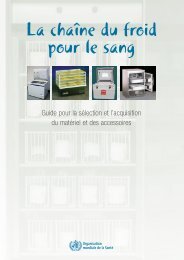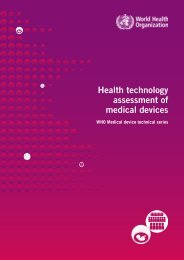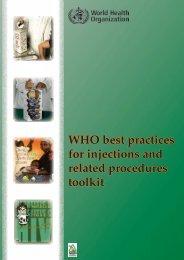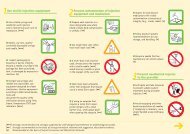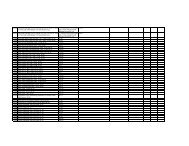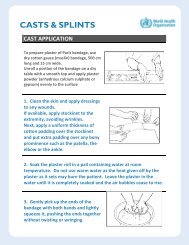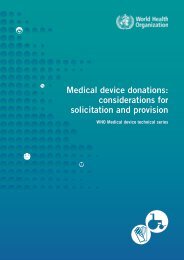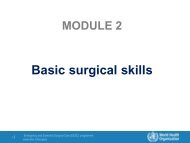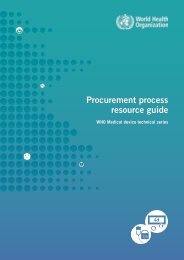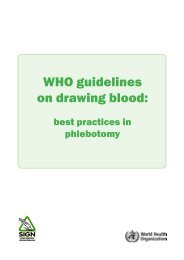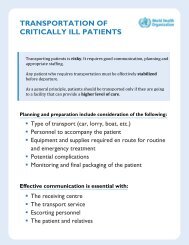WEEKLY EPIDEMIOLOGICAL RECORD, No. 12, 21 MARCH 1997
WEEKLY EPIDEMIOLOGICAL RECORD, No. 12, 21 MARCH 1997
WEEKLY EPIDEMIOLOGICAL RECORD, No. 12, 21 MARCH 1997
- No tags were found...
You also want an ePaper? Increase the reach of your titles
YUMPU automatically turns print PDFs into web optimized ePapers that Google loves.
Cholera<strong>WEEKLY</strong> <strong>EPIDEMIOLOGICAL</strong> <strong>RECORD</strong>, <strong>No</strong>. <strong>12</strong>, <strong>21</strong> <strong>MARCH</strong> <strong>1997</strong>• RELEVÉ ÉPIDÉMIOLOGIQUE HEBDOMADAIRE, N o <strong>12</strong>, <strong>21</strong> MARS <strong>1997</strong>CholéraGuinea-Bissau. Since October 1996, an epidemic ofcholera has caused around 10 000 cases and 100 deaths.The most affected areas are Bissau, where 87% of casesoccurred, and Biombo.At the time of the cholera epidemic in 1994 it was clearthat there was a need for strengthening of the country’scapacity for prevention and control activities. The Ministryof Public Health formulated a project which was financedby the Italian Government through WHO. The aim of theproject was to enable the country to control the diseasethrough the strengthening of epidemiological surveillanceactivities, training, improving diagnostic capacity and providingnecessary drugs for treatment.Despite problems such as the weakness of coordinationactivities at all levels, difficulty of access to mass media,limited access to safe water, a general lack of hygiene andsanitation in a large part of the population, as well astraditional practices during funerals, the implementationof this project has contributed significantly to improve thesituation. It has enhanced the capacity of health personnelin the surveillance and control of cholera, in the exchangeof information with other regions, in the better supervisionof training centres and availability of drugs. The Ministryof Public Health and WHO are working in close collaborationto bring the epidemic under control.Guinée-Bissau. Une épidémie de choléra a provoqué près de10 000 cas et 100 décès depuis octobre 1996. Les zones les plustouchées sont Bissau, où sont survenus 87% des cas, et Biombo.Lors de l’épidémie de choléra de 1994, il est apparu nécessairede renforcer la capacité du pays en matière de prévention et delutte. Le Ministère de la Santé publique a formulé un projet qui aété financé par le Gouvernement italien par l’intermédiaire del’OMS. Le but du projet était de permettre au pays de maîtriser lamaladie par le biais du renforcement des activités de surveillanceépidémiologique, de la formation, de l’amélioration de la capacitéen matière de diagnostic, et de la fourniture de médicamentsdestinés au traitement.En dépit de problèmes tels que le manque de coordination àtous les niveaux, de la difficulté d’accès aux médias, d’un approvisionnementlimité en eau de boisson saine, les carences en matièred’hygiène et d’assainissement dans une grande partie de la population,ainsi que les pratiques traditionnelles lors des funérailles, lamise en œuvre de ce projet a largement amélioré la situation. Il acontribué à renforcer la capacité du personnel de santé en matièrede surveilllance du choléra et de lutte contre cette maladie, àl’échange d’information avec d’autres régions, et à l’améliorationde la supervision des centres de formation et de la disponibilité desmédicaments. Le Ministère de la Santé publique et l’OMS travaillenten étroite collaboration afin de juguler l’épidémie.Articles appearing in the Weekly Epidemiological Record may be reproducedwithout prior authorization, provided due credit is given to the source.Les articles paraissant dans le Relevé épidémiologique hebdomadaire peuvent être reproduitssans autorisation préalable, sous réserve d’indication de la source.DISEASES SUBJECT TO THE REGULATIONS<strong>No</strong>tifications received from 14 to 20 March <strong>1997</strong>C – cases, D – deaths, ... – data not yet received,i – imported, r – revised, s – suspectMALADIES SOUMISES AU RÈGLEMENT<strong>No</strong>tifications reçues du 14 au 20 mars <strong>1997</strong>C – cas, D – décès, ... – données non encore disponibles,i – importé, r – révisé, s – suspectPlague • PesteAfrica • AfriqueC DMadagascar<strong>21</strong>.II-6.IIIAntananarivo ProvinceAntsirabe Health District ............... 3(1s) 1Renivohitra Health District ............ 4(1s) 1Fianarantsoa ProvinceAmbositra Health District ............. 9(2s) 1Toamasina ProvinceMoramanga Health District ........... 1(2 s ) 0■WWW access: http://www.who.ch/wer/wer_home.htmFTP: ftp.who.ch, directory/pub/wer. Username anonymousE-Mail: send message subscribe wer-reh to majordomo@who.chTelex: 415416 Fax: (41-22) 791 41 98Automatic fax reply service:Fax (41-22) 791 46 66 for reply in EnglishPrice of the Weekly Epidemiological RecordAnnual subscription Sw. fr. 230.–■Accès WWW: http://www.who.ch/wer/wer_home.htmFTP: ftp.who.ch, répertoire/pub/wer. <strong>No</strong>m de l’utilisateur anonymousCourrier électronique: envoyer message subscribe wer-reh à majordomo@who.chTélex: 415416 Fax: (41-22) 791 41 98Service automatique de réponse par fax:Fax (41-22) 791 46 67 pour une réponse en françaisPrix du Relevé épidémiologique hebdomadaireAbonnement annuel Fr. s. 230.–6.700 03.97 ISSN 0049-8114 Printed in Switzerland88


